Coronavirus Vs Swine Flu: Comparing Trump & Obama Responses to Pandemic – PT 2
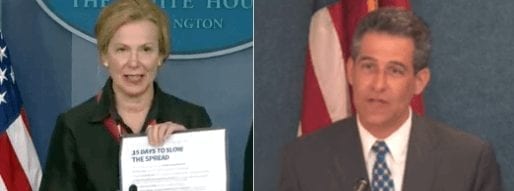
Dr. Deborah Birx of the Trump administration, and Dr. Thomas Friedman of the CDC during the Obama administration.
March 29, 2020 ~ By Shari Rose
This article is Part 2 of an ongoing series comparing the responses of the Obama and Trump administrations during times of pandemic. Please also check out Part 1: H1N1 Vs. COVID-19 ~ The First 5 Weeks.
- 6th week after initial case is detected in the U.S.
- 7th week after initial case is detected in the U.S.
- 8th week after initial case is detected in the U.S.
- 9th week after initial case is detected in the U.S.
- 10th week after initial case is detected in the U.S
6th week after initial case is detected in the U.S.
Obama administration pandemic actions (May 20, 2009 – May 26, 2009)
On May 23, the Department of Health and Human Services (HHS) asked three private drug companies to “make enough swine flu vaccine to immunize at least 20 million people in key positions in health care, national security and emergency services.”
This request came as part of a $1 billion federal government plan to further widespread testing and production of the H1N1 vaccine so that Americans could be inoculated by the end of the year, if they chose to do so. To be clear, this was not an enforcement of the Defense Production Act, but rather a formal request that these companies accepted.
In an effort to control panic and answer questions related to the H1N1 virus, Director of the CDC’s National Center for Immunization and Respiratory Diseases, Anne Schuchat, spoke with reporters at length on May 26. She answered questions related to a potential resurgence of the virus in the fall, explained how the CDC tracks and reports cases, and spoke about vaccine preparations being made in response to that expected resurgence.
H1N1 numbers by end of sixth week
On May 25, the CDC reported 6,764 cases in the U.S., and 10 deaths. The following day, the WHO confirmed 12,954 cases of H1N1 throughout the world, and 92 deaths.
Trump administration pandemic actions (Feb 25, 2020 – Mar 2, 2020)
On February 25, the CDC said the spread of coronavirus was “inevitable.” This is a stark contrast from the messages put forth from the White House, which had been working to minimize the threat perceived by the public’s perception from COVID-19.
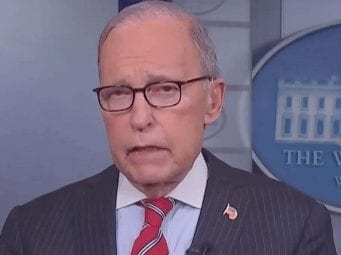
White House official Larry Kudlow says the coronavirus has been contained in the U.S. on February 25, 2020. (Source: White House)
For example, White House National Economic Council Director and former television personality, Larry Kudlow, directly contradicted the CDC, saying, “We have contained this, I won’t say airtight but pretty close to airtight.”
As the country knows, this was, and continues to be, untrue.
On the same day, the the Trump administration asked Congress for $2.5 billion to aid in the fight against coronavirus. Additionally, the CDC announced that it was working with the Department of Homeland Security at 11 airports where flights from China were coming in to screen travelers for the virus.
Meanwhile, Trump tweeted about a prominent Senate Democrat: “Cryin’ Chuck Schumer is complaining, for publicity purposes only, that I should be asking for more money than $2.5 Billion to prepare for Coronavirus. If I asked for more he would say it is too much. He didn’t like my early travel closings. I was right. He is incompetent!”
Public official sounds alarm on lack of PPE in fighting coronavirus
Through a Freedom of Information Act request, it was discovered that public health officials at HHS, the Department of Homeland Security (DHS), the State Department, and other governmental bodies, were notified on February 25 that medical workers would not have enough personal protective equipment, such as masks and face shields, when treating patients with coronavirus in the coming weeks and months.
It does not appear that any action was taken as a result of these emails.
The next day, Trump lashed out at the media for what he believed to be unfair coverage of his handling of the pandemic crisis: “Low Ratings Fake News MSDNC (Comcast) & @CNN are doing everything possible to make the Caronavirus look as bad as possible, including panicking markets, if possible. Likewise their incompetent Do Nothing Democrat comrades are all talk, no action. USA in great shape!”
Trump speaks about COVID-19 with task force
During a coronavirus task force meeting on February 26 in the White House, Trump said:
“We’re ready to adapt and we’re ready to do whatever we have to as the disease spreads, if it spreads. As most of you know, the — the level that we’ve had in our country is very low, and those people are getting better, or we think that in almost all cases they’re better, or getting. We have a total of 15. We took in some from Japan — you heard about that — because they’re American citizens, and they’re in quarantine. And they’re getting better too.”
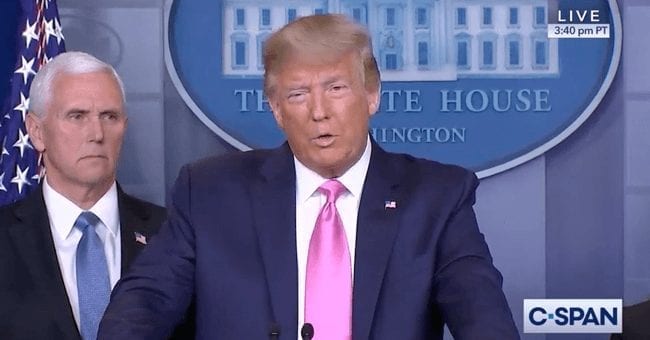
Trump speaks about the coronavirus situation in the U.S. with the White House task force on February 26, 2020. (Source: CSPAN)
When asked if he expected any economic setbacks from COVID-19, Trump answered: “No, we’re going to have tremendously low unemployment. We’re setting records on that one. In fact, the administration has the — as you know, the lowest average unemployment of any administration in history.”
Additionally, Trump again made the argument that coronavirus was no more dangerous than the seasonal flu, saying: “This is a flu. This is like a flu.”
However, when comparing mortality rates, COVID-19 is much deadlier than the common flu. The mortality rate for the seasonal flu is between .04% to .16%. The current mortality rate for the coronavirus is 1.2%. In other words, coronavirus is somewhere between 7x to 30x more deadly than the seasonal flu.
Trump shares his theories about coronavirus
On February 27, the global death toll reached 2,800 with more than 82,000 cases worldwide.
That same day, Trump said the coronavirus will “disappear.” He said, “One day – it’s like a miracle – it will disappear. And from our shores, we — you know, it could get worse before it gets better. It could maybe go away. We’ll see what happens. Nobody really knows. The fact is, the greatest experts – I’ve spoken to them all. Nobody really knows.”
Still on February 27, the Trump administration sought to further control information concerning the coronavirus when it was announced that scientists and government officials would have to have their public statements and appearances approved by Vice President Mike Pence before sharing their findings.
Typically, in democracies, science isn’t treated this way, and the flow of information concerning public health is easily accessible.
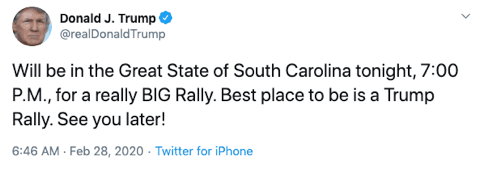 Trump tweeted that same day: “Congratulations and thank you to our great Vice President & all of the many professionals doing such a fine job at CDC & all other agencies on the Coronavirus situation. Only a very small number in U.S., & China numbers look to be going down. All countries working well together!”
Trump tweeted that same day: “Congratulations and thank you to our great Vice President & all of the many professionals doing such a fine job at CDC & all other agencies on the Coronavirus situation. Only a very small number in U.S., & China numbers look to be going down. All countries working well together!”
On February 28, Trump went to a rally for himself in South Carolina.
First COVID-19 death in the U.S.
The first death on U.S. soil from coronavirus was reported on February 29 in Washington state, though two earlier deaths on February 26 would later be attributed to COVID-19. On February 29, Trump tweeted “THE BEST IS YET TO COME!”
The following day, Secretary of Health and Human Services Alex Azar said that the government had tested 3,600 people for the virus. However, this was not true. Two days later, CDC Principal Deputy Director Anne Schuchat had to clarify that 3,000 specimens had been taken from about 500 people, meaning that the CDC had tested only about 500 Americans by early March.
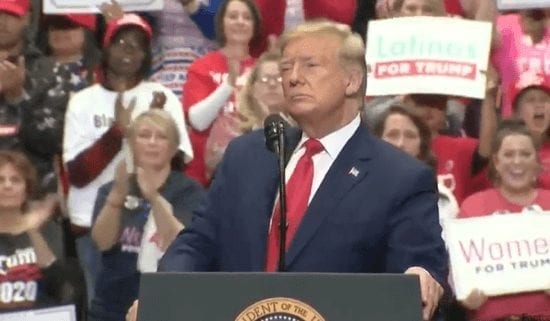
Trump speaks about coronavirus, and other topics, during his rally in Charlotte, NC on March 2, 2020. (Source: FactBase)
While at a political rally for himself in Charlotte, NC, Trump told the crowd: “We had a great meeting today with a lot of the great companies and they’re going to have vaccines, I think relatively soon. And they’re going to have something that makes you better and that’s going to actually take place, we think, even sooner.”
However, Dr. Anthony Fauci told Trump earlier that day that a vaccine was “a year to a year and a half” away.
On March 2, Trump continued to hype a “ Great American Comeback” on Twitter. He wrote “Jobs are booming, incomes are soaring, poverty is plummeting, confidence is surging, and we have completely rebuilt the awesome power of the U.S. Military. PROMISES MADE, PROMISES KEPT!”
COVID-19 numbers by end of sixth week
On March 2, 53 cases of COVID-19 were confirmed in the U.S., but widespread testing would still be weeks away, keeping numbers of domestic cases artificially low. Health officials across the country continued to warn that the nation needs national testing to understand the scope of the virus and contain it. Globally, there were 88,948 cases of coronavirus, and 3,043 deaths.
More stories: The Cruelty of U.S. Migrant Detention Facilities in 2020
More stories: Police Killings of Unarmed Black People: Why The ‘Bad Apples’ Defense Falls Apart
7th week after initial case is detected in the U.S.
Obama administration pandemic actions (May 27, 2009 – June 2, 2009)
By May 27, the CDC had produced multiple candidate vaccine viruses (CVV) for H1N1. A CVV is a virus created by public health officials, and is a major step in manufacturing a vaccine.
The following day, Dr. Anne Schuchat again spoke with journalists about H1N1 in the U.S., including current efforts being made by the administration to curb infection rates and produce a vaccine. She spoke at length about how the H1N1 virus differs from typical influenza strains, common symptoms of this virus Americans should look out for, as well as ongoing education efforts from the administration to keep Americans in the loop of what their government is doing during the pandemic.
On June 2, Obama made an additional request for funding for the H1N1 virus, $2 billion on top of the request for $1.5 billion that Congress was mulling over:
“Out of an abundance of caution, I ask the Congress to consider an additional and contingent request for $2 billion and other authorities to enhance our Nation’s capability to respond to the potential spread of this outbreak. These funds should be provided with maximum flexibility to allow us to address this emerging situation.”
H1N1 numbers by end of seventh week
On June 1, a total of 10,053 probable and confirmed U.S. cases of H1N1 were reported by the CDC, as well as 17 deaths. Globally, there were 17,410 cases of H1N1 swine flu, and 115 deaths.
Trump administration pandemic actions (March 3, 2020 – March 9, 2020)
During this seventh week, Trump continued to attack Democrats on Twitter. On March 3, Trump tweeted about Michael Bloomberg (and later deleted this tweet), saying “Mini Mike, don’t lick your dirty fingers. Both unsanitary and dangerous to others and yourself!”
The following day, Trump attacked the mayor of Los Angeles, Eric Garcetti on Twitter:
“The Mayor of Los Angeles, @ericgarcetti, is dealing with us trying to get the Federal Government to fix the terrible problem he and the Dems have caused with the homeless, and the horrendous effects it is having on the City, which is a mess. I then watch him talk “trash” on me!”
Trump makes false claims about COVID-19, blames Obama for lack of testing
March 4 was a busy day for the Trump administration.
Firstly, Trump and Vice President Mike Pence met with CEOs of major airlines in the White House. During that meeting, Trump said, “The Obama administration made a decision on testing that turned out to be very detrimental to what we’re doing. And we undid that decision a few days ago so that the testing can take place in a much more accurate and rapid fashion. That was a decision we disagreed with. I don’t think we would have made it, but for some reason it was made. But we’ve undone that decision.”
Trump, nor any member of his administration, has ever specified what this Obama-era rule was, and no public health officials are aware of what the president was talking about. There was no past rule that slowed COVID-19 testing now.
In a phone interview with Sean Hannity of Fox News later that evening, Trump said that the Obama administration “didn’t do anything about” the H1N1 swine influenza in 2009. As documented by this organization, and virtually all major news organizations in U.S., the Obama administration took the threat of H1N1 seriously from the beginning, and has outpaced the Trump administration on nearly all pandemic actions, week by week.
During the same interview, Trump said he doubted the death rates of COVID-19, as put forth by the WHO:
“Well, I think the 3.4 percent is really a false number. Now, this is just my hunch, and — but based on a lot of conversations with a lot of people that do this, because a lot of people will have this, and it’s very mild. They will get better very rapidly.”
Finally, Trump appeared to suggest that asymptomatic people with coronavirus could go to work while recovering:
“So, if we have thousands or hundreds of thousands of people that get better just by, you know, sitting around and even going to work – some of them go to work, but they get better.”
The next day, Trump attacked the media for reporting on his comments: “I NEVER said people that are feeling sick should go to work. This is just more Fake News and disinformation put out by the Democrats, in particular MSDNC. Comcast covers the CoronaVirus situation horribly, only looking to do harm to the incredible & successful effort being made!”
National shortage of COVID-19 testing kits continues
On March 5, Pence visited a 3M factory and admitted, “We don’t have enough tests today to meet what we anticipate will be the demand going forward.”
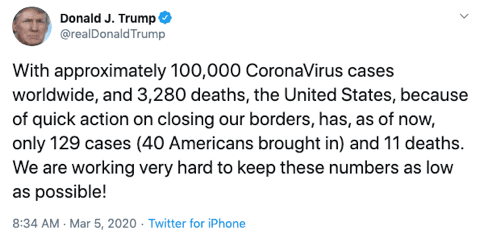 When HHS Secretary Alex Azar spoke with ABC News on March 6, he directly contradicted the vice president, saying “There is no testing kit shortage, nor has there ever been.”
When HHS Secretary Alex Azar spoke with ABC News on March 6, he directly contradicted the vice president, saying “There is no testing kit shortage, nor has there ever been.”
However, that same day, medical professionals around the country continued to document the conditions they saw on the ground, saying that testing kits were in extremely short supply, as their frustration was getting louder and more desperate.
In California, for example, it’s estimated that only 516 people total had been tested for COVID-19 by March 6. Nearly 40 million people live in the state.
Trump promises that “anybody” can get a test
After a tour of the CDC building in Atlanta, Trump repeated the assertion that there are no shortages or other issues with testing for coronavirus on March 7, saying:
“Anybody that wants a test can get a test. That’s what the bottom line is.”
He continued: “Anybody right now and yesterday — anybody that needs a test gets a test. We — they’re there. They have the tests. And the tests are beautiful. Anybody that needs a test gets a test.”
However, that is not true. The following day, Azar doubled back on both their comments, this time saying, “You may not get a test unless a doctor or public health official prescribes a test.”
On March 6, Trump signed an $8.3 billion spending bill to fight coronavirus. VIDEO.
During that signing, Trump lauded the low number of confirmed cases in the U.S. and attributed that number to his border policies: “And in terms of deaths, I don’t know what the count is today. Is it 11? Eleven people? And in terms of cases, it’s very, very few. When you look at other countries, it’s a very tiny fraction because we’ve been very strong at the borders.”
Again, it’s the lack of testing that keeps these numbers artificially low until widespread testing begins to take hold at the end of March.
On March 7, Trump visited his private club, Mar-a-Largo, in Florida. When asked if he will continue to hold rallies in light of the spreading coronavirus, Trump said:
“Well, we’ll have tremendous rallies. And we’re doing very well. And we’ve done a fantastic job with respect to that subject on the virus.”
With the breaking news that an attendee of CPAC, a conservative conference Trump also attended, tested positive for the virus, he was asked if he had any concerns that coronavirus was closer to D.C.
Right before he ended the briefing, Trump said, “No, I’m not concerned at all. No, I’m not. No, we’ve done a great job. Thank you very much.”
On March 9, Trump retweeted a post from a private citizen that criticized Obama’ response to the swine flu. The tweet erroneously said that Obama waited until October 2009 to declare a public health emergency. However, as this organization and countless others have already reported, Obama declared swine flu a public health emergency in April, the same month that the first U.S. case was confirmed.
COVID-19 numbers by end of seventh week
On March 9, there were 647 confirmed cases of COVID-19 in the U.S. Around this time, private organizations began tracking the number of tests conducted in this country, as information from federal agencies haven’t been as extensive thus far.
A total of 3,951 coronavirus tests had been administered in America by March 9, 2020.
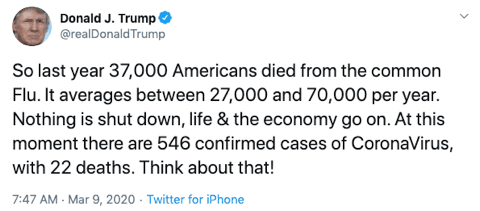
8th week after initial case is detected in the U.S.
Obama administration pandemic actions (June 3, 2009 – June 9, 2009)
On June 4, Dr. Anne Schuchat again spoke with reporters about the state of H1N1 in the U.S. Some topics she discussed were: the high proportion of young people being hospitalized from the virus, what doctors had learned about swine flu, and again the steps the CDC was taking to produce an H1N1 vaccine before the fall.
In an effort to increase government transparency, the Obama administration released Data.gov on June 8, a site dedicated to providing in-depth data about a range of topics in the U.S., including H1N1. It continues to work to this day, unlike other Obama-era websites that were shut down when Trump took office, such as Flu.gov.
H1N1 numbers by end of eighth week
On June 5, there were 13,217 confirmed and probable cases of H1N1 in the U.S., and 27 deaths. Internationally, the WHO confirmed 25,288 cases, and 139 deaths on June 8.
Trump administration pandemic actions (March 10, 2020 – March 16, 2020)
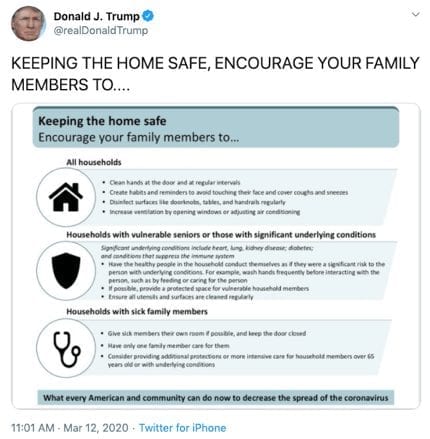
Doubling down on a greater pattern of attacking perceived enemies and touting the economy, Trump began tweeting on March 10, where he singled out Michigan:
“If you like automobiles, how can you vote for a Democrat who all want to get rid of cars, as quickly as possible, especially if they are powered by gasoline. Remember also, no more than one car per family. I, on the other hand, have new plants being built all over Michigan, Plus!”
The same day, Trump tweeted about unemployment numbers: “Best unemployment numbers in the history of our Country. Best employment number EVER, almost 160 million people working right now. Vote Republican, unless you want to see these numbers obliterated!”

Trump’s Oval Office speech about COVID-19
On March 11, Trump addressed the nation from the Oval Office to discuss the threat from COVID-19. During that speech, he erroneously announced that “we will be suspending all travel from Europe to the United States for the next 30 days.”

He continued to say that there “will be exemptions for Americans who have undergone appropriate screenings.”
While Trump clarified his error on Twitter later that evening (ban only applied to goods, not people), the damage was largely already done. This error set off a panic for Americans living or vacationing in Europe, and airports across the continent were flooded the next day with U.S. citizens believing they would be stranded in Europe and rushing to return home.
Additionally, no European countries were consulted or notified of the ban before the announcement.
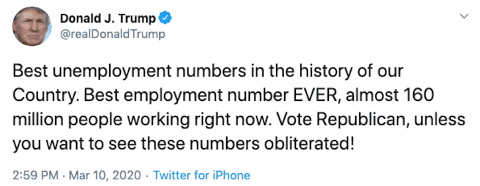 Interestingly, Trump’s original European ban did not affect the countries where he holds properties, namely the United Kingdom and Ireland. Those two countries were eventually added to the banned list once this was publicly pointed out.
Interestingly, Trump’s original European ban did not affect the countries where he holds properties, namely the United Kingdom and Ireland. Those two countries were eventually added to the banned list once this was publicly pointed out.
During that same address to the nation, Trump also claimed that health insurers “have agreed to waive all co-payments for coronavirus treatments, extend insurance coverage to these treatments, and to prevent surprise medical billing.”
Again, this was not true. Health insurance companies have agreed to waive copayments for COVID-19 testing, but will not cover treatments for positive cases.
The next morning after his speech, the New York Stock Exchange stopped trading for 15 minutes because S&P instantly dropped 7%.
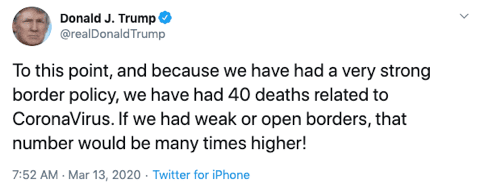
Trump responds to pandemic criticism, refuses responsibility
During a press briefing on March 13, Trump was asked about the dismantling of the National Security Council office in 2018. The National Security Council was directly responsible for handling pandemics, bioterrorism, and related crises. In May 2018, newly appointed National Security Advisor John Bolton pushed out its director, Timothy Ziemer, and disbanded the members of that team.
The Trump administration never replaced any of these positions, so the NSC remained gutted in 2020. When a reporter asked about the state of this office, Trump responded with:
“Well I just think it’s a nasty question because what we’ve done is … we’ve saved thousands of lives because of the quick closing. And when you say me, I didn’t do it … I don’t know anything about it.”
In addition to refusing responsibility for the removal of a critical arm of the country’s pandemic response, Trump brushed off the fact that there was still no widespread testing for coronavirus, saying:
“No, I don’t take responsibility at all. Because we were given a — a set of circumstances, and we were given rules, regulations and specifications from a different time. It wasn’t meant for this kind of — an event with the kind of numbers that we’re talking about.”
While it’s unclear what set of circumstances Trump was talking about, it’s clear he does not take responsibility all the same.
Later that day, Trump declared a National Emergency concerning coronavirus in the U.S.
White House unveils “15 Days to Slow the Spread”
On March 15, Pence’s coronavirus task force held a press briefing. Pence addressed the testing shortage, saying:
“We’re going to continue to work very diligently, hour by hour, day by day, in the days ahead to expand testing around the country and access to this extraordinary, and unprecedented national public-private partnership for diagnostic testing.”
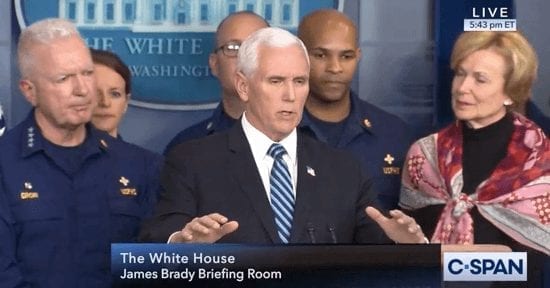
Vice President Mike Pence speaks about COVID-19 preparations with White House task force on March 15, 2020. (Source: CSPAN)
This same day, it’s estimated that a total of 25,724 tests had been administered in the U.S. since the pandemic began.
The following day, the White House announced a program called “15 Days to Slow the Spread,” which is a nationwide effort to slow the spread of COVID-19 through the implementation of social distancing at all levels of society.
COVID-19 numbers by end of eighth week
On March 16, there were 4,226 confirmed of COVID-19 in the U.S., and 71 deaths. A total of 40,123 of Americans had been tested for coronavirus since the pandemic began.
More stories: Living Statues of Trump Appear in DC as Form of Protest
More stories: El Negro Matapacos & the Riot Dogs Who Protect Protesters
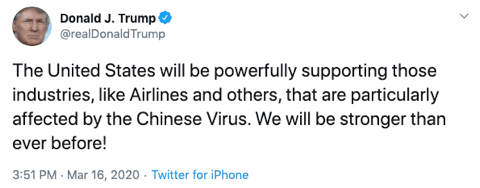
Trump says U.S. will support airlines and others affected by “Chinese Virus” on March 16, 2020.
9th week after initial case is detected in the U.S.
Obama administration pandemic actions (June 10, 2009 – June 16, 2009)
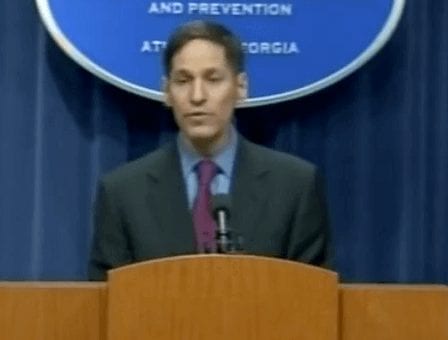
CDC Director Tomas Frieden speaks about H1N1 developments in the U.S. on June 11, 2020. (Source: CDC)
The CDC held a press briefing with Director of the CDC, Dr. Tomas Frieden, and Dr. Anne Schuchat, a deputy director also with the CDC. When speaking about H1N1 in the U.S., Frieden said, ”It’s in all likelihood here to stay, and it’s important that we continue our aggressive efforts to prepare and respond. Our key goals are to determine where the virus is spreading and to reduce its impact, particularly on those who are most vulnerable – people with underlying health conditions and infants, as well, in this case.”
In addition, Schuchat confirmed during this June 11 briefing that there was “ongoing transmission of this novel virus” in the country, and that every state has at least one case.
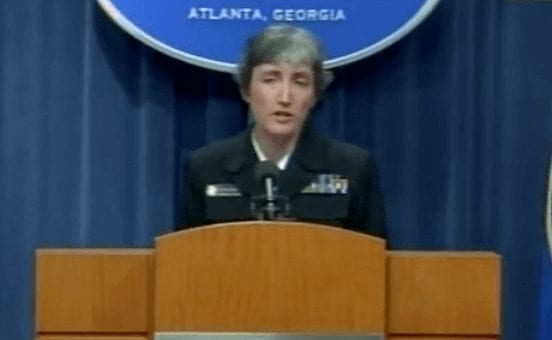
Dr. Anne Schuchat of the CDC confirms every state has cases of H1N1 swine flu on June 11, 2020. (Source: CDC)
As with past press briefings, these health officials answered questions from the press about the spread of the virus, their current work on vaccine efforts, and so forth.
H1N1 numbers by end of ninth week
The CDC reported 17,855 cases of H1N1 in the U.S. on June 12, and 44 deaths. Three days later, the WHO reported 35,928 global cases of H1N1 swine flu, and 163 deaths.
Trump administration pandemic actions (March 17, 2020 – March 23, 2020)
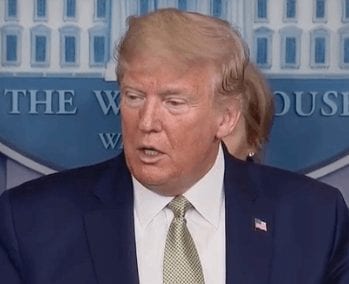
Trump speaks to reporters about COVID-19 in the U.S. on March 17, 2020. (Source: CSPAN)
On March 17, Trump asserted that he has called coronavirus in the U.S. a pandemic all along, saying “I felt it was a pandemic long before it was a pandemic.”
This is not true. Throughout January and February, Trump had downplayed, minimized and simply lied about the growing threat of COVID-19 in the U.S. until the medical reality finally got in the way.
For example, three days after the first U.S. citizen died of coronavirus, Trump theorized that the virus would disappear in April: “You know, a lot of people think that goes away in April with the heat — as the heat comes in. Typically, that will go away in April.”
The following week, Trump tweeted that COVID-19 “is very much under control in the USA.” From the day that was tweeted, February 24, to one month later on March 24, an additional 54,438 cases of coronavirus would be confirmed in the U.S.
Continuing on March 17, Trump attacked Michigan’s governor on Twitter, saying “Failing Michigan Governor must work harder and be much more proactive. We are pushing her to get the job done. I stand with Michigan!”
The reason Trump went after Michigan’s governor is because she criticized the federal government’s response to the pandemic, saying the Trump administration “hasn’t been prepared” for the coronavirus.
On March 18, a scientist in Montana was blocked by the Trump administration to “conduct experiments on possible treatments” for COVID-19 because of laws blocking research on human fetal tissue. The scientist spent almost a month appealing to officials, saying that a pandemic warrants exemptions. However, the Trump administration stopped this scientist’s efforts to find a treatment for coronavirus.
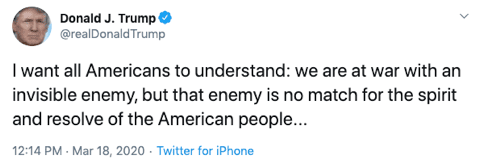
CDC loosens PPE recommendations as medical supply shortages expose workers
On March 19, the CDC loosened its recommendations on the proper use of medical masks and other protective gear as widespread shortages of personal protective equipment hit U.S. hospitals. In fact, it advised that scarves and bandanas could be used as protection against coronavirus as a last resort.
Health care workers denounced this recommendation, saying they are being exposed to the virus. One week later, a nurse in NYC will die from COVID-19 because he had to resort to using trash bags as protective gear while treating patients.
The same day on March 19, Trump shrugged off responsibility for medical equipment shortages. He said, “Nobody in their wildest dreams would have ever thought that we’d need tens of thousands of ventilators. This is something very unique to this, to what happened.
However, U.S. public officials who study and prepare for pandemics for a living have accurately predicted the national need for ventilators. None of this is a mystery to those whose job it is to protect us from influenza. For example, the New England Journal, estimates that the U.S. currently has “60,000 to 160,000” ventilators. However, it also estimates that “the number of ventilators we will need to care for U.S. patients with COVID-19, from several hundred thousand to as many as a million.”
Trump erroneously says he invoked the Defense Production Act
During a coronavirus task force meeting on March 20, Trump said multiple times that he had invoked the Defense Production Act. This act allows the government to nationalize private companies to produce essential medical supplies, such as ventilators and masks.
As Trump said, “I invoked the Defense Production Act, and last night, we put it into gear.”
Two days later, however, FEMA administrator Pete Gaynor said Trump had not enforced the Defense Production Act at all. Some companies decided to donate equipment of their own accord, but the act itself was never enacted. It will be another week until it the Act is invoked.
During a press briefing about COVID-19 at the White House, a reporter asked Trump the following question:
“What do you say to Americans who are watching you right now, who are scared?”
This is Trump’s full response, unedited:
“I’d say that you’re a terrible reporter, that’s what I’d say. I think that’s a very nasty question. And I think it’s a very bad signal that you’re putting out to the American people. The American people are looking for answers, and they’re looking for hope, and you’re doing sensationalism, the same way with NBC and Comcast. I don’t call it Comcast, I call it Concast. Let me just tell you something, that’s really bad reporting. And you oughta get back to reporting instead of sensationalism. Let’s see if it works. It might, and it might not. I happen to feel good about it. Who knows, I’ve been right a lot.”
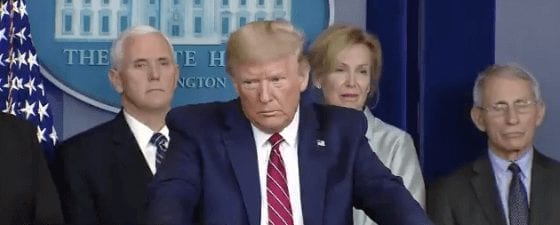
Trump listens to a question from reporter Peter Alexander in the White House on March 20, 2020. (Source: CSPAN)
What should have been a slam-dunk, easy question for any president to answer instead became a tirade against the media and general criticism that his administration is unprepared for this pandemic. All Trump had to do was show a little empathy for Americans who are frightened, and he failed to do this bare minimum as a leader.
White House pushes plan to blame China for outbreak
On March 21, it was discovered that the White House had made concerted efforts across multiple federal agencies to blame China for the coronavirus outbreak.
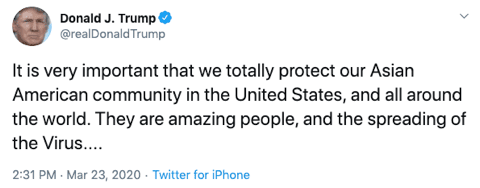 A cable was sent to U.S. officials at the State Department that laid the groundwork for how to respond to questions about COVID-19, as they relate to China. Incidentally, these correspondence seem to coordinate with Trump’s apparent preference to call coronavirus, the “Chinese Virus.”
A cable was sent to U.S. officials at the State Department that laid the groundwork for how to respond to questions about COVID-19, as they relate to China. Incidentally, these correspondence seem to coordinate with Trump’s apparent preference to call coronavirus, the “Chinese Virus.”
In part, the wire blames the Chinese government for not being forthcoming about the severity of coronavirus in their country:
“The government hid news of the virus from its own people for weeks, while suppressing information and punishing doctors and journalists who raised the alarm. The Party cared more about its reputation than its own people’s suffering.”
Unfortunately, the irony of that messaging was lost on the Trump administration.
DOJ asks for power to detain people indefinitely & without trial
Another significant federal government action was taken on March 21.
The Department of Justice quietly asked Congress for the power to ask chief judges to detain Americans indefinitely without trial during emergencies, such as a pandemic.
However, due to widespread pushback from Democrats, it does not appear this measure would ever pass Congress.
Dr. Fauci contradicts Trump during press conference
During a coronavirus task force meeting with the press on March 21, a journalist asked Trump about reports of shortages of medical equipment, including surgical masks. While Trump tried to shut down the questions, Dr. Fauci stepped forward, saying “We don’t take lightly what you just read … I get the calls every night.”
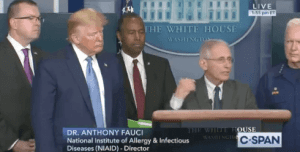
Dr. Anthony Fauci contradicts Trump concerning reports of medical equipment shortages in the U.S. during COVID-19 on March 21, 2020. (Source: CSPAN)
He continued, “It’s a serious issue, we don’t want that to happen. But it is happening. You’re not making things up. I know that because I’m experiencing it myself.”
Dr. Fauci was missing from a subsequent White House task force meeting on March 24.
On March 21, medical professionals at epicenters of coronavirus outbreaks, including New York City and Los Angeles, began to restrict testing to the most vulnerable populations, including the elderly and health care professionals. The reason? Massive shortages on protective medical equipment that keeps doctors and nurses from exposure to the virus.
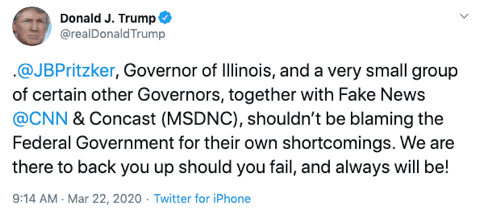
The same day, the FDA approved the first coronavirus test in the U.S. that delivers results in a few hours, instead of a few days. It should be noted that other countries, including Senegal and South Korea, have provided rapid-result tests for COVID-19 for some weeks.
COVID-19 numbers by end of ninth week
On March 23, there were 44,183 cases of COVID-19 in the U.S., and 471 deaths. A total of 279,473 tests had been completed in the U.S. since the outbreak began.
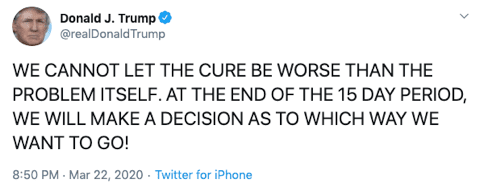
10th week after initial case is detected in the U.S.
Obama administration pandemic actions (June 17, 2009 – June 23, 2009)
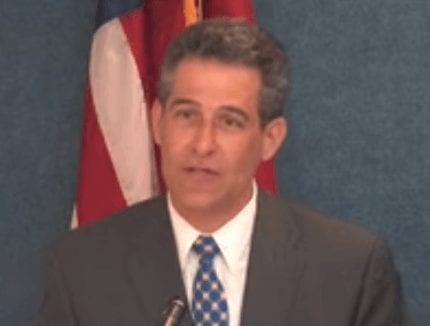
Dr. Richard Besser from the CDC speaks about H1N1 and hurricane preparedness on June 17, 2009. (Source: American Red Cross)
Director of the CDC’s Coordinating Office for Terrorism Preparedness and Emergency Response, Dr. Richard Besser, appeared at the National Press Club on June 17 to discuss the impact of H1N1 influenza on hurricane season: “It’s really important that people are open and honest so that they can get proper treatment, but also so they’re not going to be getting other people ill.”
On June 18, two directors from the CDC, Dr. Daniel Jernigan and Dr. Michael Bell, spoke with reporters about what they know about H1N1, and what the CDC is doing to prepare and protect the U.S. from a potential resurgence of the virus later in the year.
The following day, it was confirmed that all 50 states and territories had cases of the H1N1 virus.
The Supplemental Appropriations Act, a bill that contained an additional $1.5 billion for response to swine flu, was passed by the U.S House on June 19. Obama signed it into law the following week.
H1N1 numbers by end of tenth week
On June 25, a couple days after the tenth week ended, the CDC reported a total of 27,717 cases of H1N1 in the U.S., as well as 127 deaths. Globally, there were 55,867 cases, and 238 deaths.
Trump administration pandemic actions (March 24, 2009 – March 30, 2020)
On March 24, Trump tweeted about providing 400 ventilators to New York:
“The World market for face masks and ventilators is Crazy. We are helping the states to get equipment, but it is not easy. Just got 400 Ventilators for @NYCMayor Bill de Blasio. Work beginning on 4 hospitals in New York! Millions of different type items coming!”
 However, NYC Mayor Bill de Blasio estimated that New York would need tens of thousands of ventilators in the coming weeks, and argued the federal government needs to provide more: “Four hundred ventilators? I need 30,000 ventilators,” he said. “You want a pat on the back for sending 400 ventilators? You’re missing the magnitude of the problem and the problem is defined by the magnitude.”
However, NYC Mayor Bill de Blasio estimated that New York would need tens of thousands of ventilators in the coming weeks, and argued the federal government needs to provide more: “Four hundred ventilators? I need 30,000 ventilators,” he said. “You want a pat on the back for sending 400 ventilators? You’re missing the magnitude of the problem and the problem is defined by the magnitude.”
The same day, Trump showed impatience with social distancing, as multiple states with bad outbreaks enforce stay-at-home rules to lower rates of transmission. He tweeted:
“Our people want to return to work. They will practice Social Distancing and all else, and Seniors will be watched over protectively & lovingly. We can do two things together. THE CURE CANNOT BE WORSE (by far) THAN THE PROBLEM! Congress MUST ACT NOW. We will come back strong!”
On March 25, Trump lied on Twitter about COVID-19 testing numbers in the U.S., writing:
“Just reported that the United States has done far more “testing” than any other nation, by far! In fact, over an eight day span, the United States now does more testing than what South Korea (which has been a very successful tester) does over an eight week span. Great job!”
This is not true. As of March 27, South Korea tested .7% of its population for the coronavirus. The U.S. had tested .2% of its population.
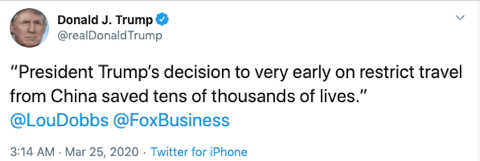
On March 26, HHS Secretary Alex Azar tweeted incorrect information concerning social distancing and CDC guidelines. His tweet explained that only people who are ill, have underlying health conditions, are elderly, or have someone in the home with COVID-19 should practice social distancing. This is patently untrue. Everyone needs to be practicing social distancing to lower rates of transmission, particularly because asymptomatic cases go unknown.
On March 27, Trump tweeted about General Motors, in regard to the Defense Production Act:
“As usual with ‘this’ General Motors, things just never seem to work out. They said they were going to give us 40,000 much needed Ventilators, ‘very quickly’. Now they are saying it will only be 6000, in late April, and they want top dollar. Always a mess with Mary B. Invoke ‘P’.”
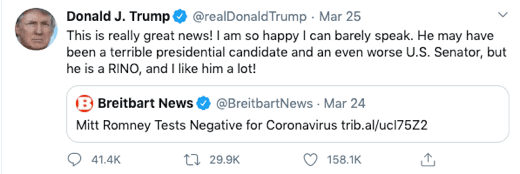 As stated before, Trump still had not invoked the Defense Production Act, as it was discovered that’s what he meant by “P.” After this tweet, Trump announced that he had signed a memorandum requiring GM to produce medical equipment.
As stated before, Trump still had not invoked the Defense Production Act, as it was discovered that’s what he meant by “P.” After this tweet, Trump announced that he had signed a memorandum requiring GM to produce medical equipment.
The same day, Trump continued to attack Michigan’s governor:
“I love Michigan, one of the reasons we are doing such a GREAT job for them during this horrible Pandemic. Yet your Governor, Gretchen “Half” Whitmer is way in over her head, she doesn’t have a clue. Likes blaming everyone for her own ineptitude! #MAGA”
Dr. Birx pushes back on reports of DNR conversations in U.S. hospitals

Dr. Deborah Birx holds sign containing the Trump administration’s “15 Days to Slow the Spread” plan to help contain COVID-19 on March 26, 2020. (Source: CSPAN)
Dr. Deborah Birx, White House coronavirus response coordinator, downplayed the threat of coronavirus in the U.S.during a March 26 press briefing, and called out reports of medical professionals that had begun discussing what to do if their hospitals don’t have enough ventilators, and other life-saving equipment:
“To wake up this morning and see people talking about creating DNR situations – do not resuscitate situations for patients – there is no situation in the United States right now that warrants that kind of discussion.”
However, hospital systems across the U.S. have since come forward to confirm they have had conversations about potential DNR (do not resuscitate) situations as the peak of the coronavirus will hit in the coming weeks.
For example, Geisinger Health System serving New Jersey and Pennsylvania confirmed that “conversations about whether to change DNR practices are taking place within its hospitals,” but they are not making changes at this time. Other hospitals around the country are having those conversations as well, especially as other countries hit hard by the virus, such as as Italy and Spain, have made those exact resuscitation decisions in recent weeks.
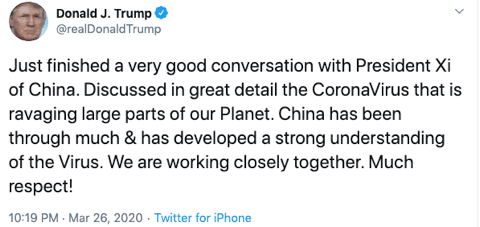
During the same press conference on March 26, Birx explained that the administration is looking to classify counties as low-risk, medium-risk, and high-risk for the coronavirus as a way to limit national social distancing measures and get people back to work.
However, a reporter pointed to the fact that there are no domestic travel restrictions among counties. Meaning a person from a high-risk county and visit a low-risk county and spread the virus to other areas of the country.
This is Birx’s response to that question, in full:
“I think this is a very important concept, and it’s why we really worked on messaging to the American people about these 15 days to stop the spread. Because part of this would be the need to have highly responsible behavior between counties. And I think the American people can understand that, they will understand where the virus is because we’ll have the testing data and where it isn’t, and make sure that they are taking appropriate precautions as they move in and out of spaces. I think this will be critical for our future as we work together to really understand where this virus is, and where it isn’t in real time.”
It shouldn’t have to be pointed out, but viruses don’t follow county borders, and neither do Americans. Even in a perfect world, the notion that there will be clear-cut lines in outbreaks based on county lines doesn’t work as asymptomatic people will continue to move freely across these borders and infect as they go.
During a White House briefing on March 27, Trump said he tells Pence to avoid calling governors that are not appreciative enough of what he’s doing:

“I say, ‘Mike, don’t call the governor of Washington, you’re wasting your time with him; don’t call the woman in Michigan—it doesn’t make any difference what happens.’”
Trump is referring to Michigan Governor Gretchen Whitmer and Washington Governor Jay Inslee, two leaders with a combined 17 million people in their states.
Trump sows confusion with federal quarantine tease
On March 28, Trump announced that he was considering a federal quarantine of New York, New Jersey and Connecticut, saying “ a decision will be made, one way or another, shortly.”Seven hours later, he tweeted that a “quarantine will not be necessary”, but not before many residents in those states panicked about what to do, and local leaders said publicly they had not been notified about a possible quarantine.
On March 29, Trump selected certain sentences from a New York Times piece and tweeted them as one full quote. These tweets compare his “ratings” to those of The Bachelor and Monday Night Football.
His comments, posted on Twitter, in full:
“President Trump is a ratings hit. Since reviving the daily White House briefing Mr. Trump and his coronavirus updates have attracted an average audience of 8.5 million on cable news, roughly the viewership of the season finale of ‘The Bachelor.’ Numbers are continuing to rise. On Monday, nearly 12.2 million people watched Mr. Trump’s briefing on CNN, Fox News and MSNBC, according to Nielsen — ‘Monday Night Football’ numbers. Millions more are watching on ABC, CBS, NBC and online streaming sites, and the audience is expanding. On Monday, Fox News alone attracted 6.2 million viewers for the president’s briefing — an astounding number for a 6 p.m. cable broadcast, more akin to the viewership for a popular prime-time sitcom. The CBS News poll said 13 percent of Republicans trusted the news media for information about the virus.” Michael M. Grynbaum @NYTimes”
It’s hard to read this and not think that the coronavirus pandemic is just a ratings game for Trump. If the presidency is his reality show, the American people are his audience.
But what Trump fails to understand is that Americans are watching these developments in record numbers because we are terrified. We are sick and dying of a virus that has no cure and no vaccine.
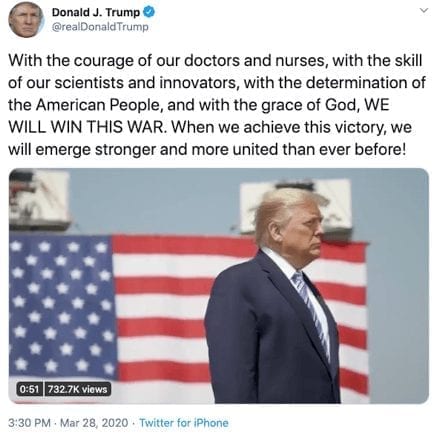 We have watched doctors leave behind the dead in Italy and Spain as hospitals are overwhelmed with coronavirus patients. Otherwise healthy people, those in their 30s and 40s, are dying in this country from this very serious epidemic. American nurses and doctors make desperate pleas on social media for medical equipment to keep their patients, and themselves, alive.
We have watched doctors leave behind the dead in Italy and Spain as hospitals are overwhelmed with coronavirus patients. Otherwise healthy people, those in their 30s and 40s, are dying in this country from this very serious epidemic. American nurses and doctors make desperate pleas on social media for medical equipment to keep their patients, and themselves, alive.
By tweeting about his “ratings” during a deadly pandemic, Trump demonstrates that he is our reality show president, and he believes he is succeeding because he has our attention.
And as the audience of his reality show, and we will continue to pay the price for whatever he feels like doing next. Though perhaps someone in the White House should let him know that he’s about to permanently lose a swath of his audience, as U.S. pandemic modeling shows.
COVID-19 numbers by end of tenth week
On March 30, there were 160,530 cases of COVID-19 in the U.S., and 2,939 deaths. Overall, 944,854 tests have been administered in America since the outbreak began. Globally, there were 715,660 cases of coronavirus, and 33,579 deaths.
Part 1: H1N1 Vs. COVID-19 ~ The First 5 Weeks
Share this story
 |
 |
 |
 |
 |
 |







0 Comments